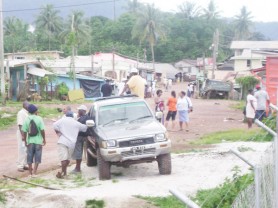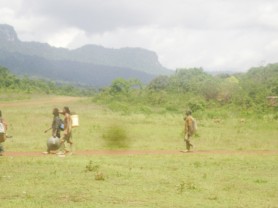-mainly mining community bustling with activity
“Mahdia is the most wonderful place in Guyana!”, exclaimed Omeica Alphonso, a mother of three and popular fast food vendor who told Stabroek News that she was born there and lived in the mining community all her life.
Omeica is one of several roadside food vendors who serve the bustling and developing Mahdia on a daily basis with a variety of foods ranging from fish and chips, roti and curry to Chinese food among other delicacies.
This newspaper caught up with a few residents while on a visit to the area two weeks ago.
According to Gerald Rawlins, a shopkeeper who migrated to the area a few years ago from the coastland, the entire community, inclusive of the numerous stalls, shops, bars, eating houses and guest houses, depend on the mining activities to stay afloat. He said over the years the area has developed with some miners settling down and an influx of coastlanders.

Another resident, a father of five, said that the area has the potential to attract more tourists sometime in the near future. He said, however, there is need for marketing Mahdia to the tourism world since there are many natural and man-made sites there which can compete with other tourist sites around Guyana. He listed the majestic Eagle Mountain which stands behind the airstrip as a natural beauty. He pointed out that the community has an effective transportation system, by air or road, which makes access to the community from the coastland easy. The dredge owner launched an appeal to the relevant authorities to consider Mahdia as a tourist attraction noting that accommodation is also available to visitors.
Residents there make full use of the public transportation system; Route 72 mini-buses

travel from Georgetown to Mahdia each day and while the plane ride offers one the luxury of viewing the area from the top, it is equally adventurous to see the various sights by road. The buses leave Mahdia for Georgetown at various times before noon and around midnight. Miners in the community take advantage of the service offered by the minibus operators for the transport and delivery of their mail and ‘top ups’ for loved ones on the coastland.
One such miner is Anthony Haime, 42, a father of five who hails from Sophia. When Stabroek News spoke to him at Mahdia’s only Chinese restaurant, he was busy plastering an envelope with lots of tape which was intended for his wife in Georgetown. He said he works hard each day in the ‘back dam’ at Mahdia to support his family.
While Haime has the interest of his family at heart, some of his colleagues have been following a different priority. According to ‘Cutty’, another miner who has been in the mining industry for nearly a decade, he never really thought of saving his earnings until he got a rude awakening one day when he broke his left hand and was penniless for a few months while recovering from the injury. As he sipped an alcoholic beverage, the young man said he spent thousands of dollars at Mahdia as well as at other mining communities where he worked prior to moving to the area.
As he lamented what he called his ‘carelessness’ in the past, the 32-year-old man explained that working in the mines has its ups and downs, with bad weather being a jinx for many dredge owners. He said he and his colleagues are paid according to the amount of gold produced, being $4000 a person per ounce of gold at his current employer. Some days the dredge owner would make adjustments to working hours, for which payments are deferred, this development giving the men headaches.
As the sun rises above the mountains surrounding Mahdia the miners, inclusive of a few pork knockers (miners who work independently with their batels, shovels etc, among other tools), sit about in front of the various food shops waiting for breakfast to be served. Most times the food handlers are yelled at as some call for their orders which were put in 30 minutes to an hour before. While Omeica, the young woman who declared that Mahdia was the best, prepares her food during the day to catch the evening hustle, others prepare food for lunch time but these orders are not much in number.
Curt and Shawn, two career miners told Stabroek News that the mining camps would have their designated cook, known as the `bahir’, who prepares lunch for them during the day.
When activities subside later in the night, he said he and his colleagues would trek through various tracks for about 20 to 25 minutes to their camps where their hammocks await them.
Curt, with his torchlight tucked in his waist, puffing a cigarette as he related his daily ups and downs said that most of the miners in the area work for periods of time with different dredge owners. He explained that some of the factors which dictate this are competitive payments by dredge owners, unavailability of work due to the dredge owner closing his operations for long periods as well as the miner’s desire to move to another area. He said he once worked with dredge owners in the North West area and kept walking south with stops at mining camps where he sought employment. As he headed farther south he eventually stopped at Mahdia since the dredge owner he works with pays him more than $4000 per ounce of gold produced by him and his colleagues, which he said is a reasonable rate.
As the sun sets behind the mountains close to the mining area, the hard-working miners emerge in their numbers from different corners of the community. What makes their faces even brighter is the thought of having loads of cash in their pockets as they approach the “centre of town”, the thought of all the things money can buy swirling in their minds; one miner briefly recounted a night back in February when he ’blew out’ $60,000 on drinks, fast food, his friends and ladies of the night.
As night steps in, the community’s central spot, which is landmarked by a cenotaph standing at the junction of the main roads in the community, erected in 1986 in memory of soldiers who fought in the two world wars, dozens of persons mainly miners, walk to and fro as some search for dinner, some for entertainment and others for the sake of avoiding boredom. Music from the various roadside shops, discos and guest houses blares and any new visitor to the community would have a hard time settling on a sound system to tune his/her ears to since they are so many. Different types of vehicles can be seen around the community at this time with ‘bush’ trucks occupying most of the parking space available along the road. Miners can be seen standing along the road with various beverage bottles in hand and munching from Styrofoam boxes containing mainly fish and chips.
Approaching midnight, the hive of activity tends to subside as shop keepers close their doors leaving a few persons walking up and down the main public road. Most of them at this time are ladies of the night. According to residents in the area, these sex workers travel to Mahdia from the coastland and book rooms at guest houses in the area for periods of time and they are usually paid huge sums for their services, a few miners revealed.
While the area has basic infrastructure established in most parts and most persons appear to enjoy life, there are a few problems which the residents said should be addressed. One such issue is the availability of water. Regional Chairman Senor Bell told Stabroek News that the problem with the water system, which is a Caribbean Development Bank project, is a result of gravel and such particles clogging sections of a reservoir located about five miles from the area at Eagle Mountain. He noted that miners, who have been working close to sections of the road damaging and even using the water to complement their activities, also contribute to the problem. He said when the rainy season subsides, which he estimates as being late next month, a dredge will be taken into the area to clear the reservoir. He said the problem developed about two months ago but he personally has been addressing the issue.
Another issue highlighted by an educator is the negative influence certain activities in the community may have on children. He said this area is of great concern since many in the community seem to turn a blind eye to the impact of activities such as lewd music emanating from the many shops as well as the availability of illegal drugs on the roads at night. He said this should be addressed urgently saying that the unavailability of co-curricular activities may leave youths in the area to adapt to unscrupulous activities. Bell told Stabroek News that the establishment of a resource centre for the training of youths in various trades is currently being examined.
Approximately 4,000 persons live in the Mahdia. The figure also includes residents from the nearby Amerindian village of Campbell Town, a community which is governed by a village council with a Toshao at its helm.
From August 14-16, the area will host its annual Mahdia Day celebrations, a cultural event which usually attracts thousands of persons to the bustling community, where, according to Bell, development has progressed rapidly over the past decade.





